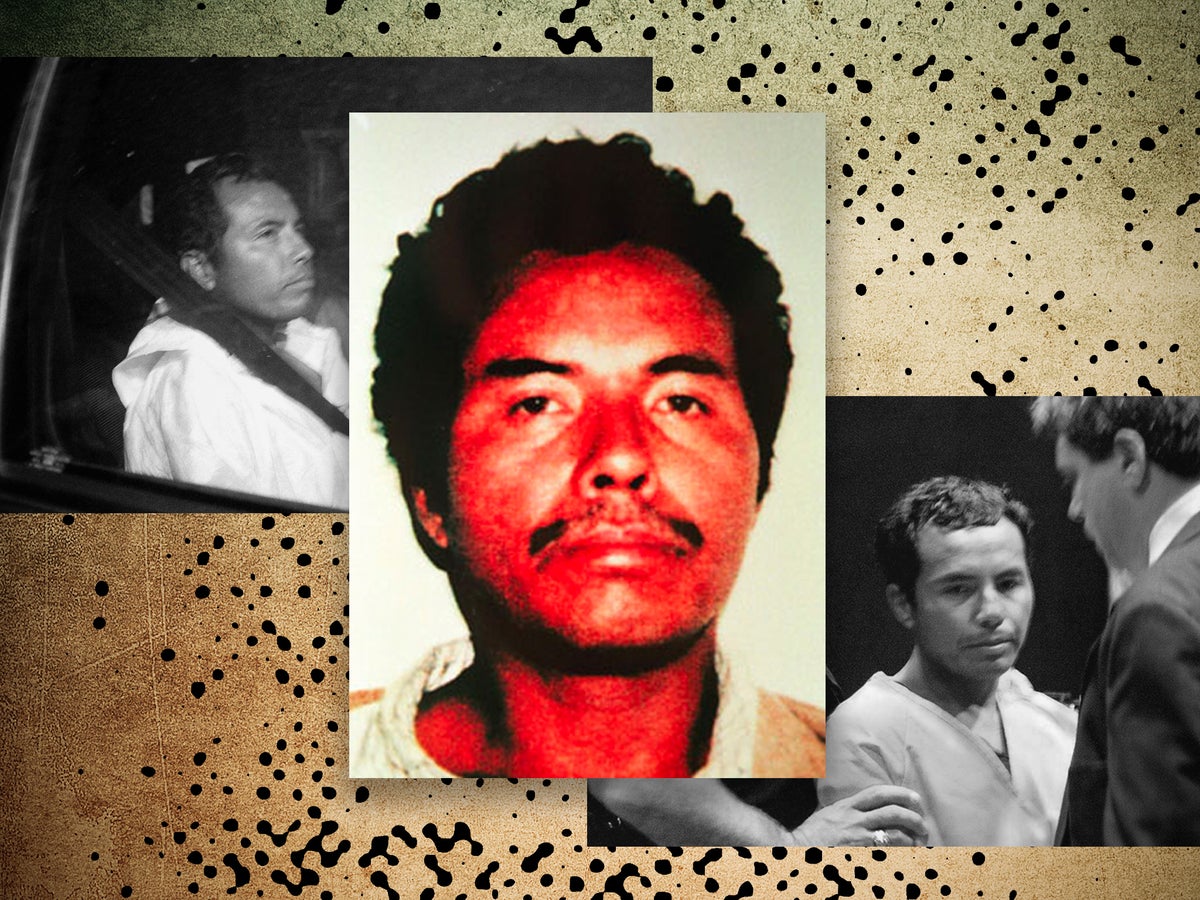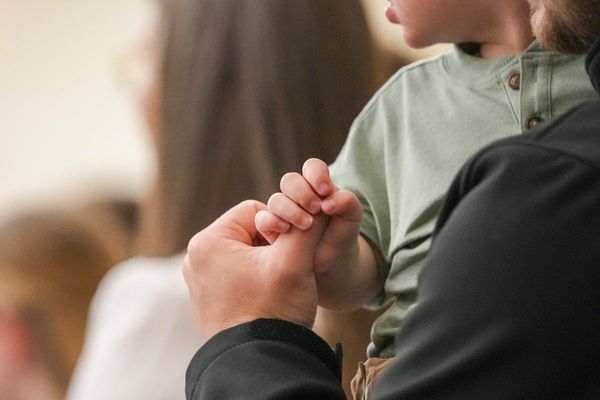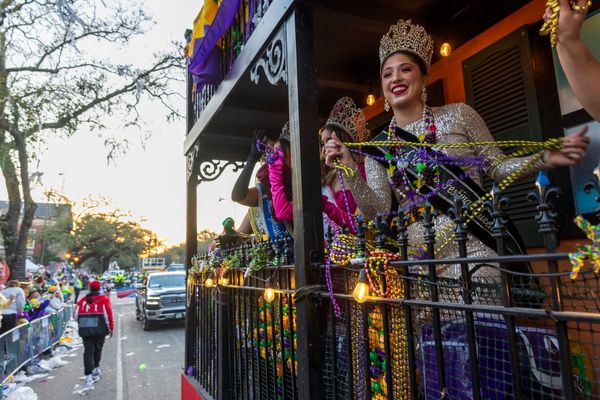
Local Police Chief Randy Kennedy stared out the window of his friend Leafie Mason’s home in Hughes Springs, trying to come to terms with the fact that he’d just discovered her battered body in a bedroom inside.
The East Texas lawman had known Mason since he was 16, and he couldn’t imagine how or why anyone would hurt the now-87-year-old – especially in such a violent manner.
She’d been beaten to death with a blunt object, her purse left open in the bathroom with her wallet identification displayed almost like a trophy.
Chief Kennedy looked at the window at the back of the house, figuring it had been pried open, and spotted two palm prints. Then he looked a bit further.
“Just right across the street is the railroad track,” he says in Netflix’s Catching Killers. “No one in the community would do this to her. It just hit me that it had to be the train.
“Somebody got off the train, came over here and murdered her and got back on the train and left.”
He resolved then and there to never rest until he found Mason’s murderer – a determination that sparked the manhunt to find the so-called Railroad Killer as he prowled America’s 140,000 miles of railroad track.
From the Hughes Springs police department to the Texas Rangers and the FBI, officers across the country – along with private citizens and bounty hunters hoping for a $125,000 reward – hunted for the phantom killer slipping in and out of quiet communities with a murderous intent in the 1990s.
Then – just over nine months after Chief Kennedy discovered Mason’s body – the killer was caught.
Angel Maturino Resendiz, who also went by the alias Rafael Resendez-Ramirez, surrendered to a Ranger on the El Paso border.
The so-called Railroad Killer’s reign of terror was over, and he would pay for it with his life seven years later when he was executed in Texas’ death chamber – just under 200 miles from the scene of Mason’s murder and from where his mistakes would ultimately lead to his undoing.
When Chief Kennedy surveyed his murdered friend’s home that night in 1998, he noticed not only the preserved palm prints and the proximity to the train tracks but also a half-eaten meal that he suspected the killer may have left behind.
He spent weeks attempting to match palm prints to other transient rail riders in the area and eventually contacted other law enforcement agencies in Texas, looking for murders with similarly unusual characteristics. It wasn’t long before he received a call from Sgt Ken Macha of West University Police, around a five-hour drive north.
“The MO was very familiar with the case I had here,” Chief Kennedy says in the series.
Dr Claudia Benton, a mother of two young children, had been murdered in her home on 17 December 1998 – bludgeoned with a bronze figurine and stabbed with a knife in her bedroom. Her purse and ID were displayed. Again, half-eaten food had been left at the scene.
This time, however, so had a fingerprint – and it matched to a Mexican national with a long history of arrests: Rafael Resendiz-Ramirez. The local lawmen thought they’d identified their man, but they had “no address, no permanent location,” Sgt Macha says in Catching Killers.
They enlisted the broader help of the Texas Rangers – and with it Drew Carter and his trademark hat. The Ranger’s swagger and style seemed to come straight out of central casting for the legendary force.
“I learned that, not only has he been arrested multiple times, he’s been all over the place,” Mr Carter says in the series. “He’s been arrested in Michigan, California, East Coast, Texas. He’s all over. We really don’t have a a pattern as far as figuring out where he might go. What made this very challenging is that, each time that he was arrested, he provided a different name, a different date of birth and, in some cases, a different social security number.”
During the hunt to find him, the killer struck again on 2 May 1999 – this time claiming two victims, and in a church parsonage, no less. Norman and Karen Sirnic were bludgeoned with a sledgehammer in Weimer, Texas, fewer than 100 miles from where Dr Benton was killed. The crime lab linked the two killings through DNA, and authorities were now certain they had a serial killer on their hands.
It was time to bring in the FBI, including Special Agents Thomas McClenaghan and Kim Barkhausen, who were assigned to work in tandem with Mr Carter.
“To try to find someone who is jumping on and off trains is a horrendous problem,” Agent McClenaghan says in the docuseries, explaining his philosophy when he joined the case.
“I want to get this story out into the media so that everybody in the United States is looking for him,” he says. “We need to get him in front of every screen, [on the] front of every newspaper, so that all of America is looking for this guy. We print 400,000 fliers which contain his photographs, his description, both English and Spanish. We send leads to all 56 FBI field offices to go out to all migrant camps. all soup kitchens, any place that a transient would be staying at and just blanket the area with these fliers and hopefully a lead will come out of that.”
‘Railroad Killer’ Angel Maturino Resendiz, alias Rafael Resendez-Ramirez, was arrested in 1999 after a nationwide manhunt and executed in Texas seven years later— (AFP/Getty)
Agent McCleneghan also tasked Agent Barkhausen with looking “at all the cases you can come up with looking at IDs, eating food, occurring along railroad tracks ... because we don’t know if there’s ten more out there or fifty more out there,” he says in the Netflix show.
The Railroad Killer’s details were entered into a federal database and cross-referenced with other unsolved cases across the States – and within hours another case was identified in Kentucky in 1997. College students Holly Dunn and Christopher Maier were attacked that August as they walked along the tracks; she survived, but he tragically succumbed to his injuries.
“The murders have taken place now not 100 miles apart but states apart,” Mr Carter says in the series, still wearing his hat. “And the timeframe of two years has [passed]. The murders haven’t stopped, and they’re probably going to continue.”
They did. About a week after the connection was made to the Kentucky attack, the Railroad Killer was tied to the murder of 73-year-old Josephine Konvicka, who was found bludgeoned with a pickaxe in her Dubina, Texas, bedroom. The killer had displayed a newspaper featuring an article about the Sirnic murders at the scene – along with a toy train in a box.
“He recognises that he has an identity now; not only is he a serial killer, he’s the ‘Railroad Killer,’” Mr Carter says in the show. “And I think that’s something that feeds his ego.”
Investigators soon found out 26-year-old Noemi Dominguez had also been killed with a pickaxe in Houston on 4 June.
“Now we have two people killed in one day; the case is escalating,” Agent Barkhausen says. “He could be anywhere. There are 140,000 miles of railroad tracks across the US. I am scared, scared for any future victims. We have got to find this guy.”
As their desperation and worry deepened, the agents and rangers were horrified to learn that, in the midst of their search, the Railroad Killer had actually been in US custody – but was let go. Ramirez had been detained by immigration officials, but the computer system failed to flag that he was wanted for murder.
He was released – and went on to not only commit the 4 June murders but travel north to Gotham, Illinois, where he killed 80-year-old George Morber Sr and his daughter, 52-year-old Carolyn Frederick, on 15 June.
They needed to find him again fast – and, in 1999, one of the best ways to do that was to grab the nation’s attention through the TV show America’s Most Wanted.
And so Mr Carter appeared on the show – in his hat. And the calls came rolling in. One of them, very thankfully, hit the jackpot.
The ‘Railroad Killer’ was linked to at least 15 murders— (AFP/Getty)
A cousin of the serial killer made contact to say that he was using a relative’s name and had been born Angel Maturino Resendiz. He had a sister, Manuela, living in Albuquerque, and Mr Carter and Agent Barkhausen headed to her, figuring that the wanted man would have no one else to turn to other than family. They were right, and he called; the pair convinced Manuela to help them, in turn, convince her brother to turn himself in. After hours of dropped calls and snatches of negotiation, only Manuela and her brother conversing as she relayed officers’ messages, he agreed to do so.
The pair of investigators hit the road with Manuela, uncertain if he’d show.
“She trusted us,” Agent Barkhausen says in Catching Killers. “That is our biggest contribution ... that relationship that was developed.”
She says: “I'm watching Drew, walk across the border. I was just kind of monitoring. The biggest thing that can go wrong is that he doesn't decide to turn himself in, and then we're right where we were ... needle in a haystack, trying to find him. I don't know how long it will go on if this doesn't happen. I don't know how many more people are going to be his victims. So the stakes are very high.”
Incredibly, the serial killer made good on his word; Ramirez showed up.
“He was wearing blue jeans, a long sleeve shirt, glasses and a belt,” Mr Carter says in the show. “And I’m struck by how small this guy is. He was not very tall; he was like 135 pounds. Man, how can something that small have inflicted so much damage? He didn’t really talk, didnt have anything to say. I stuck my hand out and just said, ‘I’m Drew.’ And I shook his hand and just turned him around and cuffed him right there.”
The Railroad Killer had been apprehended.
The news brought relief to communities around the country, particularly those close to the tracks. Back in Hughes Springs, where Chief Kennedy’s drive to avenge his friend’s death sparked the serial killer search, it brought an element of closure.
“Houston PD confirmed the palm prints from Leafie’s house did belong to Ramirez,” he says, adding: “When they told me that, I let out ... a big, you know, whoop. I’m jumping up and down and I run down the hallway, you know, yelling to everybody: ‘We’ve got him. We’ve got him. we’ve got him.’
“And now Leafie will have justice.”
Justice also came swiftly for her killer. He was sentenced to death in May 2000 for the murder of Dr Benton, and he was executed on 27 June 2006. At the time of his death, he had been linked to at least 15 murders.
The serial killer addressed his victims’ loved ones in his last moments, asking them for forgiveness.
“I know I allowed the devil to rule my life,” he said. “I just ask you to forgive me and ask the Lord to forgive me for allowing the devil to deceive me.”
Before he took his final breaths, he acknowledged the depths of his crimes and his national campaign of fear and violence.
He added: “I deserve what I am getting.”







